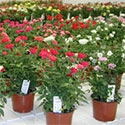Media Surfactants
General Use
What Are Media Surfactants?
Media surfactants (wetting agents, penetrants, wetters) describe a group of chemical products which aid in the wetting and movement of water in growing media. These detergent-like products work by lowering the surface tension of water and media particles so that wetting is uniform and effective. Without uniform wetting, irrigation water tends to move through the larger pores in the media (or the sides of the pot) where it is subject to downward gravitational forces. This in turn leads to increase leaching and reduced irrigation efficiency. By improving penetration, wetting, and water movement, media surfactants can increase the effective wetting area in containers thereby increasing irrigation efficiency. The fact that commercial container media are typically treated with media surfactants is evidence for their value in media performance.
The relative importance of media surfactants in plant production often increases under conditions where media dries out between irrigation applications. When media dries out, organic components (particularly peat and bark) develop hydrophobic or "water-hating" characteristics that become stronger as moisture levels decrease. Media dry-down is most common with low frequency irrigation schedules, non-uniform watering practices (including inadvertent skips or mechanical failures), small pots, and plants at later stages of production. Under these conditions, careful consideration of media surfactant management will likely have its greatest benefits.
Related Products
Media surfactants should not be confused with other related products that also aid in water management. Absorbents (hydrophilic polymers or hydrogels) are added to media to increase water-holding capacity. Unlike media surfactants, they act like an individual component and do not directly affect the wetting of the organic components of growing media. This is in contrast to media surfactants, which do not increase a growing medium's potential water-holding capacity. They do, however, minimize the amount or duration of watering that is required to achieve water-holding capacity. Also confused with media surfactants are spray adjuvants (also wetters, stickers, surfactants, spreaders). These surfactants are designed specifically for use in chemical spray solutions. They improve the activity of the associated chemical (e.g. pesticide, fungicide, etc.) by increasing the wetting of leaf and other plant tissue surfaces, much like media surfactants improve the wetting of organic media.
Management Considerations
Management may include applications at planting, maintenance applications, and/or pre-ship applications.
Media quality will determine whether applications at planting are recommended. If used in a timely manner (e.g. same season), most commercial, high-quality growing media pretreated with media surfactant will not benefit greatly from any additional application of media surfactant at planting. For growers who make their own mix or use untreated media, media surfactant can be incorporated during mixing by spraying a concentrated solution or by adding a granular product. Another option is to apply a solution of MS during initial media wetting, prior to or soon after planting. Incorporation of granular MS product is recommended for long-season crops (e.g. specimen plantings, trees and ornamentals) since many of these products have "slow-release" properties.
The value of maintenance applications will depend upon the length of the crop, the media, and the irrigation practice. Unfortunately, there are no tests for MS activity as we have for monitoring media fertility or pH. Unless a proscribed maintenance program is followed, visually monitoring irrigation penetration is probably the best, albeit subjective, method of determining the need for maintenance media surfactant applications. Maintenance applications include periodic drenching or constant feed at low concentrations in irrigation water. For longer-termed crops, top-dressed granular products can also be applied.
Pre-shipping (also called late drench) applications are made by growers to ensure effective wetting during postharvest handling and sales, when conditions may be unfavorable. Pre-ship applications involve a liquid drench but can also be applied, albeit less effectively, through sub-irrigation.
Proper Usage
Media surfactants are designed for application to media, not plants. We have not observed phytotoxicity when applied directly to the media, even at concentrations many times higher than recommended. However, if media surfactant solutions are applied 'over-the-top' and media is contacted, some phytotoxicity damage may result.
Current Projects
The Scotts Company and Aquatrols Corp. have been sponsors of media surfactant research conducted by our department. A recently completed phase of research evaluated the benefits of pre-ship applications of media surfactant on post-production performance. Currently, we are evaluating media surfactant benefits for improving water distribution in large containers under drip irrigation.
Publications
Million, J.B., J.E. Barrett and T.A. Nell. Late-season applications of media surfactant improve water retention and time to wilt during postproduction. ISHS Acta Horticulturae 543: VII International Symposium on Postharvest Physiology of Ornamental Plants.
Abstract: Several trials were conducted to compare the efficacy of preplant media surfactant treatments with treatment applications made at the end of production on wilting and water retention of potted plants in postproduction. Media pretreatment with PsiMatric (Aquatrols, NJ) at 116 mL.m-3 (3 fl. oz.yd-3) had no effect on wilting or water retention of Impatiens wallerana (10-cm pots) or Dendranthema grandiflora (13-cm pots) in postproduction. A 600 ppm PsiMatric drench applied one day before shipping delayed postproduction wilting of impatiens 33% (3.6 vs. 2.7 day) and increased water retention 129% (172 vs. 75 mL/pot). The same treatment delayed wilting of chrysanthemum 64% (8.7 vs. 5.3 day) and increased water retention 230% (199 vs. 60 mL/pot). A 1200 ppm drench applied one week before shipping was required to achieve the same effect as a 600 ppm drench applied one day before shipping. Daily applications of 150 ppm PsiMatric in irrigation water during the last week of production were as effective as a 600 ppm drench applied one day before shipping in delaying wilt and increasing water retention after wilt for Petunia hybrida (10-cm pots).


